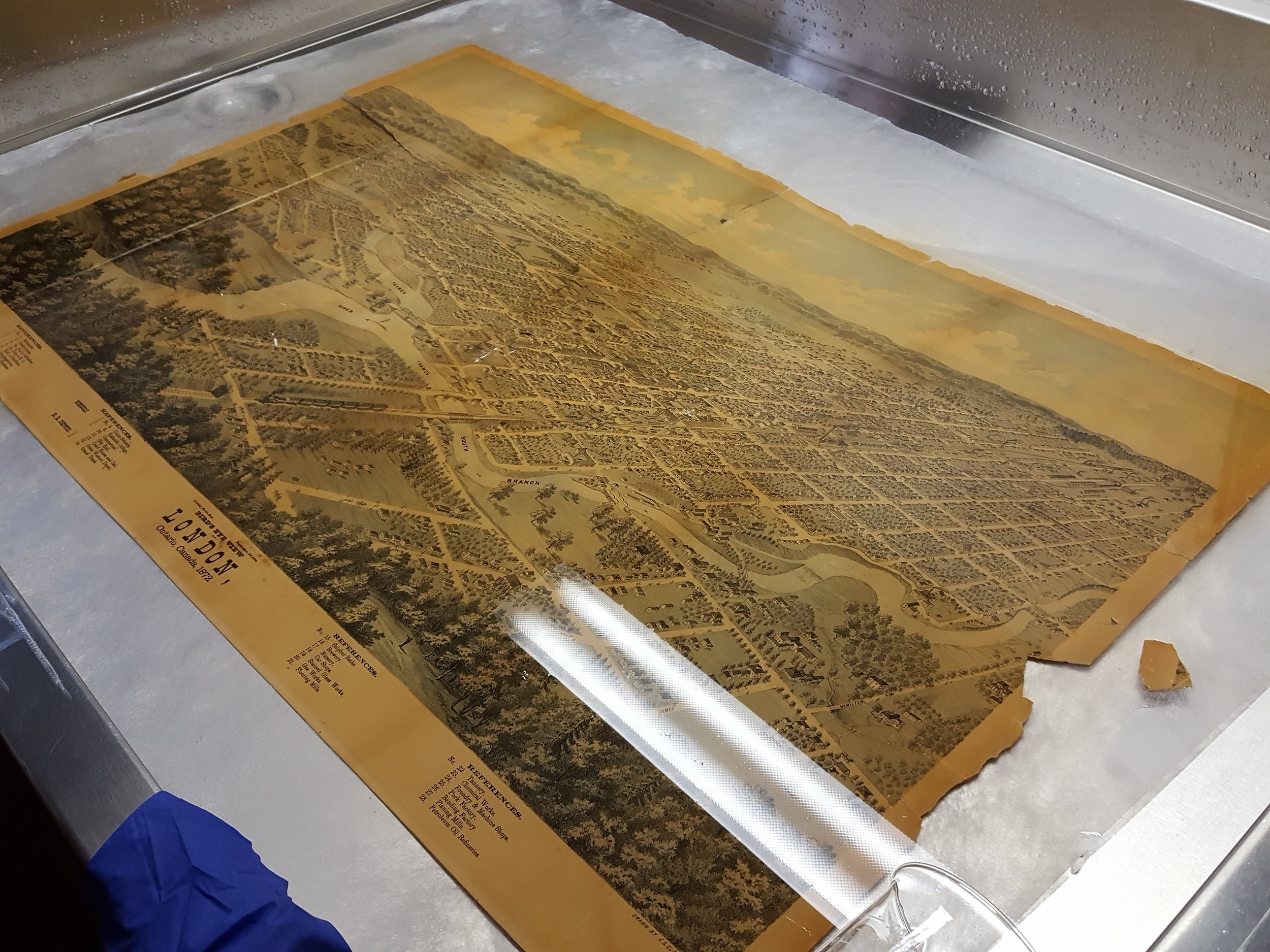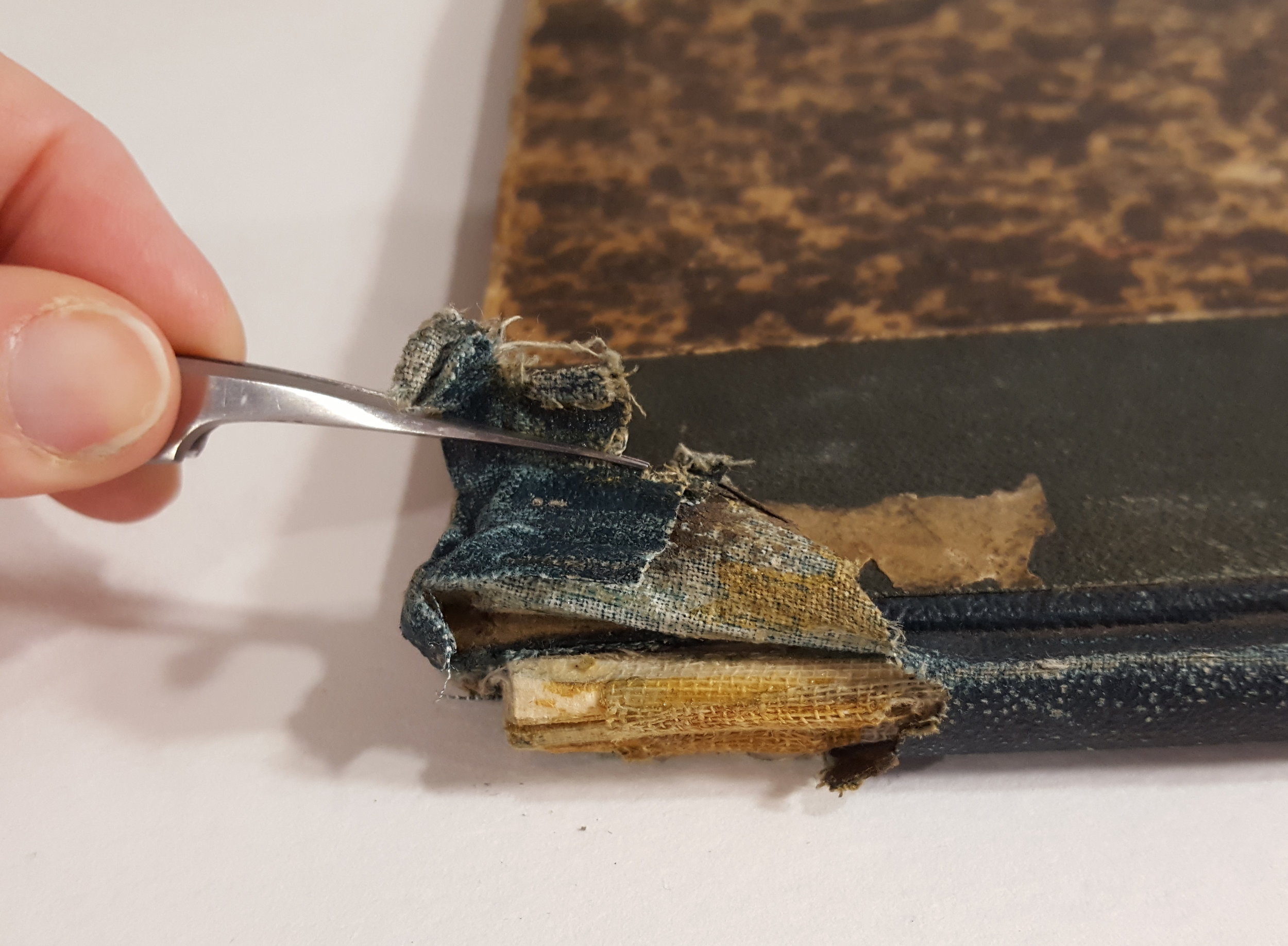A watermark from the notable papermaker J Whatman is visible in transmitted light. The map is drawn on hand-made laid rag paper.
Archival materials see some of the hardest use and wear of all paper objects, because their original purpose was usually utilitarian. Sometimes ephemeral, often consulted, maps are no exception. The maps that come in to Book and Paper Conservation Services for treatment show damages typical of handling and haphazard storage, such as tears, breaks, creases, soiling, and evidence of previous restoration as owners have performed DIY repairs in order to return functionality to an item in frequent use.
1848 Map of Sarnia, Ontario, Canada. Before conservation treatment, the map suffers surface dirt, tears and losses, as well as previous repairs with damaging adhesive tape on the verso.
An 1848 map of the town of Sarnia, Ontario that we conserved last year is a perfect example. The map, now part of the collections of the Lambton County Archives, shows several streets close to the shore of the St. Clair River, with specific lots carefully laid out and numbered and buildings and geological features marked.
The map is an original, and has been hand drawn with pen and ink, with roads and waterways highlighted in watercolour. It’s a utilitarian, yet beautiful object, with elegant penmanship and a green silk ribbon folded and sewn around the perimeter of the paper. It may be a thoughtfully designed piece, but it was meant foremost to convey information, and the handling and use it has seen are evident in the damages it now presents.
Lambton County Archives brought the map in for conservation treatment in order to preserve a delicate piece of Sarnia’s history, and make it safe for researchers to access and study.
Map in raking light, showing severe planar deformation.
The map suffered a variety of condition and damage issues caused by use and age, dating from it’s lifetime before entering the Archives. A heavy layer of surface dirt, tears and losses, and adhesive tape residue on the verso were present and needed to be addressed. After thorough condition reporting and photo-documentation, an essential step in all our conservation projects, the treatment began.
Surface cleaning using a smoke sponge is a slow and tedious process, but one which in this case yielded dramatic results. The time lapse images of the cleaning show the grime coming off section by section, brightening the paper beneath.
Surface cleaning the verso of the map.
Time lapse video showing the process of surface cleaning the map.
Next, the remains of the repair tape applied by a well-intentioned soul was addressed. The tape carrier had long since flaked off, but the adhesive residue remained, brittle and yellowed and crosslinking with the paper fibres on a microscopic level. Some solvent tests revealed a match, and by careful swab application, over suction to draw out the dissolved residue, we were successful in removing the disfiguring material. Luckily there was not much staining left in the paper after this was removed, and more stable repairs could now be applied.
Solvent removal of adhesive tape residue.
In keeping with conservation aims and ethics, a new, stable and reversible repair method was chosen, that of Japanese tissue adhered with wheat starch paste. Wheat starch paste is a clear, strong and flexible adhesive that will not fail, discolour or become brittle with time. It is used by paper conservators to attach thin strips of handmade Japanese tissue to paper objects, to repair tears and breaks. The long-fibred, acid-free tissue holds together the breaks and can be selected to match the colour and thickness of the artifact, being nearly invisible after application so that it won’t disturb the aesthetics of a piece. These repairs were performed on the verso of the map, and fills were added to the losses with a similar process, completing the repair of the mechanical damages on the map.
Japanese tissue repairs applied to the verso of the map, with LED light pad underneath.
After conservation treatment, the map is clean and stable.
After treatment the map is bright and clean, the damages are repaired and damaging materials have been removed so as not to cause further long-term deterioration. Conservation treatment has restored stability and aesthetic integrity to the map.
It was returned to Lambton County Archives as good as new, and is now kept in their newly renovated storage facility, ready to serve researchers interested in Sarnia’s early history. Please visit the Archives in person or online to learn more about their collections and the preservation strategies they undertake for artifacts in their care.
To learn more about archival conservation at Book and Paper Conservation Services, check out our portfolio section or read about our process.




























